

Image via Kairo Kiitsak.
from EarthSky https://ift.tt/2OmDaB3


Image via Kairo Kiitsak.
from EarthSky https://ift.tt/2OmDaB3

The HPV vaccine will be given to boys as well as girls, the Government announced this week, after an expert vaccine committee recommended extending the programme. The decision brings England into line with Scotland and Wales. The news was covered by The Sun and BBC News, and we blogged about what happens next.
One in 25 of 10 to 11-year olds are severely obese, according to new figures from Public Health England. We covered the report, which also showed an upward trend in the proportion of year 6 children who are overweight and obese. The Telegraph also has the story.
The immunotherapy drug pembrolizumab (Keytruda) can now be used to treat patients in England who haven’t responded or have stopped responding to standard treatment and aren’t able to have a stem cell transplant. We covered the announcement.
Over half of parents admitted to getting sunburnt in the last 12 months in the UK, results from a YouGov survey have revealed. And only 3 in 10 parents strongly agreed that they’re setting a good example to their children about sun protection. Our press release and The Times (£) have more.
One-stop clinics for patients with symptoms that could indicate cancer can cut average waiting times for a referral from 75 days to 15, according to a new study covered by Pulse. The one-stop shops studied, which carry out all tests in a single appointment, also saw three times more patients diagnosed on the same day compared with multi-stop clinics.
The way most people apply sunscreen leaves their skin with less than half the protection they expect, according to new research covered by The Guardian and BBC News. Emma Shields from Cancer Research UK said that the research confirms that when it comes to sunscreen, the key is to use it liberally and reapply regularly, and a higher SPF doesn’t provide as much extra protection as people might think.
STAT News covered some interesting, early research attempting to harness the destructive power of Zika viruses to target and kill cancer cells. The work was done using cancer cells grown in the lab from neuroblastoma, a children’s cancer that starts in nerve cells. Scientists found the virus was highly effective at killing cells from most, but not all neuroblastomas. It’s a fascinating approach, but remains a long way from being tested in people.
Katie

The HPV vaccine will be given to boys as well as girls, the Government announced this week, after an expert vaccine committee recommended extending the programme. The decision brings England into line with Scotland and Wales. The news was covered by The Sun and BBC News, and we blogged about what happens next.
One in 25 of 10 to 11-year olds are severely obese, according to new figures from Public Health England. We covered the report, which also showed an upward trend in the proportion of year 6 children who are overweight and obese. The Telegraph also has the story.
The immunotherapy drug pembrolizumab (Keytruda) can now be used to treat patients in England who haven’t responded or have stopped responding to standard treatment and aren’t able to have a stem cell transplant. We covered the announcement.
Over half of parents admitted to getting sunburnt in the last 12 months in the UK, results from a YouGov survey have revealed. And only 3 in 10 parents strongly agreed that they’re setting a good example to their children about sun protection. Our press release and The Times (£) have more.
One-stop clinics for patients with symptoms that could indicate cancer can cut average waiting times for a referral from 75 days to 15, according to a new study covered by Pulse. The one-stop shops studied, which carry out all tests in a single appointment, also saw three times more patients diagnosed on the same day compared with multi-stop clinics.
The way most people apply sunscreen leaves their skin with less than half the protection they expect, according to new research covered by The Guardian and BBC News. Emma Shields from Cancer Research UK said that the research confirms that when it comes to sunscreen, the key is to use it liberally and reapply regularly, and a higher SPF doesn’t provide as much extra protection as people might think.
STAT News covered some interesting, early research attempting to harness the destructive power of Zika viruses to target and kill cancer cells. The work was done using cancer cells grown in the lab from neuroblastoma, a children’s cancer that starts in nerve cells. Scientists found the virus was highly effective at killing cells from most, but not all neuroblastomas. It’s a fascinating approach, but remains a long way from being tested in people.
Katie
The Moon is as old as the Earth, at about 4.5 billion years of age. For as long as there have been creatures on Earth able to observe it, the Moon has been there to be seen.

The dimpled Moon. Credit: ESA/Silicon Worlds/Daniele Gasparri

Detlef during a Desert RATS ‘spacewalk’, 2011. Credit: ESA/W. Carey
In 450 BC the ancient Greek philosopher Anaxagoras realised that the Moon does not shine with its own light, instead bathing in the reflected glory of the radiant Sun. As early as 150 BC, the Greek philosopher ‘Seleucus of Seleucia’ considered the Moon to be the cause of tides on Earth.Today, we have landed on the Moon, leaving footprints, a feather from the famous “hammer-feather drop” experiment, even a cast golden olive branch lies amongst the countless other worldly possessions still orbiting Earth. More importantly we even brought lunar samples back home to study and explore. So, what more is there to know?
For a thousand years people have described witnessing mysterious, fleeting phenomena across the face of the Moon, and once we had the tools to observe its surface, we saw evidence of a history of high-energy bombardment in the countless craters and shock waves that blanket it.
It was only in 1997 that the first systematic attempts were made to identify impact flashes, and today ESA is one of a few organisations continuing to study these ‘transient lunar phenomena’.
We spoke to Detlef Koschny, ESA planetary scientist and co-manager of the near-Earth object section of ESA’s Space Situational Awareness programme, who is currently studying these impacts, finding out about the bits of space that keep smashing into our Moon…
Q: First of all, what is a lunar ‘impact flash’, and why are you interested?
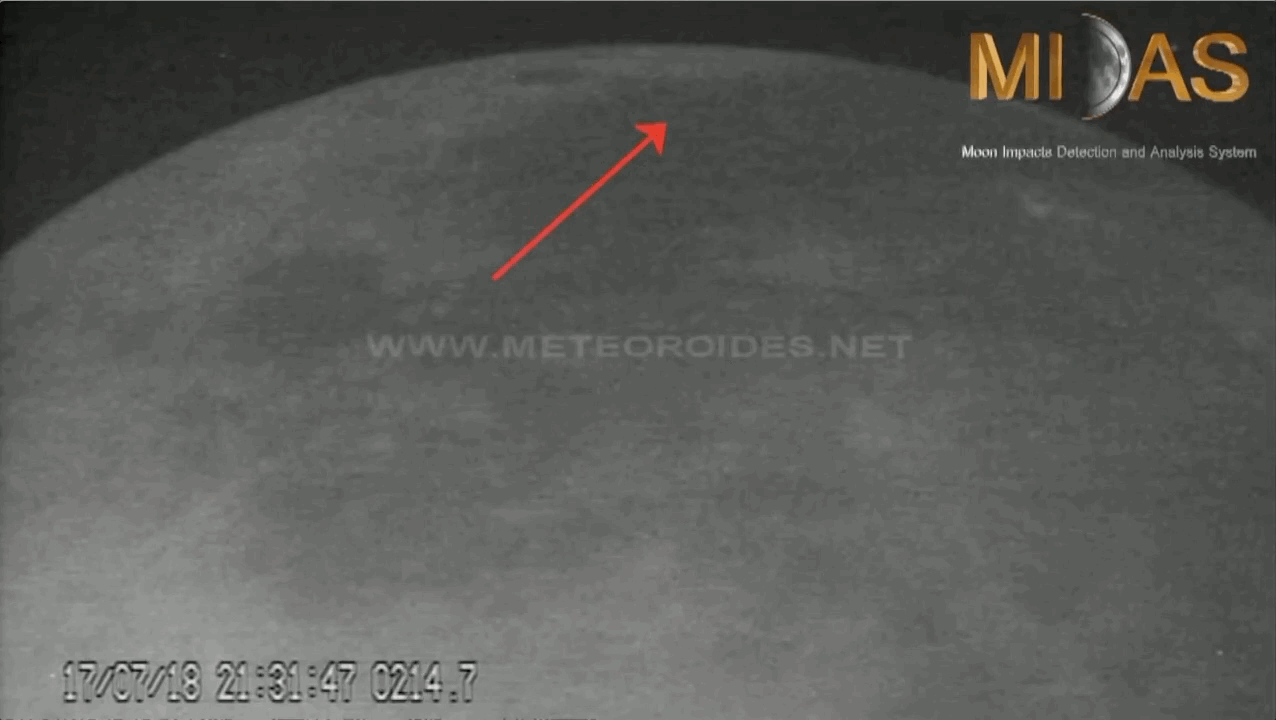
Two lunar flashes light up darkened Moon, 17 – 18 July, 2018. Credit: J. Madiedo / MIDAS
There are many small, but fascinating and ancient pieces of material travelling at high speed through space, and I am interested in the smallest of them. My main research interest is cosmic dust, meteors, fireballs, and other minor bodies in the Solar System — particularly asteroids!
When a small asteroid or meteoroid hits the Moon, part of the energy is converted to light — and this is what we see as an ‘impact flash‘.
Q: How are you involved in studying these fleeting flashes?

Rosetta’s view of the Moon, 2007. Credit: ESA
I am involved in two projects whose main focus is lunar micrometeoroid impacts. NEOLITA was launched by ESA at at the National Observatory of Athens in February, 2015. It aims to determine the distribution and frequency of small near-earth objects (NEOs) by monitoring lunar impact flashes, using the 1.2m Kryoneri telescope located in the Northern Peloponnese, in Greece.
Like all other impact flash monitoring programmes, NEOLITA only observes impact flashes only on the dark side of the Moon — note that the dark side is entirely different to the far side!
Unlike the ‘far side’ of the Moon which always faces away from Earth (and has a slightly different surface) the dark side refers to any part of the Moon that is not currently illuminated by the Sun, although — such as during a crescent Moon — it may still be facing Earth.
Then there is LUMIO — the Lunar Meteoroid Impact Observer. ESA set a challenge last year (2017) — “Imagine sending a spacecraft the size of an airline cabin bag to the Moon – what would you have it do?” and LUMIO was one of the two successful answers!
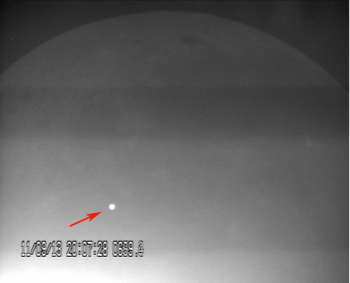
The largest lunar flash ever recorded, September 2013. Credit: J. Madiedo / MIDAS
The plan is that LUMIO would circle over the far side of the Moon to detect bright impact flashes during the lunar night, mapping meteoroid bombardments as they occur!
Q: How common are they, and what can they tell us?
NELIOTA sees one flash on average every 2-3 hours of continuous observation time, so from that we can calculate that there are really are several per day.
The light flash lets us estimate the size and velocity of the object that hit it, and from this we can better understand how many of these objects hit the Moon, and how often. This is of particular interest to future astronauts that spend any time on the Moon! But this information also helps us understand the general environment that Earth and the Moon find themselves in — with some scaling factors to account for the different gravity of the two bodies, we can use the lunar data as a proxy for impacts into Earth’s atmosphere.
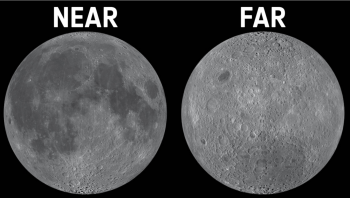
Differences between the near and far sides of the Moon. Credit: ESA
Q: How do impacts on the Moon differ from those on Earth?
Earth’s atmosphere protects us from objects smaller than about 20 metres, so to get impact craters on our surface we need even bigger asteroids that can survive, intact, before they reach the ground. On the Moon everything reaches the ground, because it doesn’t have an atmosphere. This means that we get ‘hypervelocity’ impact craters even from very small objects that impact it.
Q. Why are impacts on the dark side of the Moon important to study? Are they any different?
Impacts are the same everywhere on the Moon, but it is much easier to see the flash of light they cause if they occur on the dark, rather than illuminated, side. This is for the same reason that we can only see faint stars only at night and not during day — the contrast is just not high enough.
Q: Will the July 2018 eclipse provide any useful insights into lunar impacts?
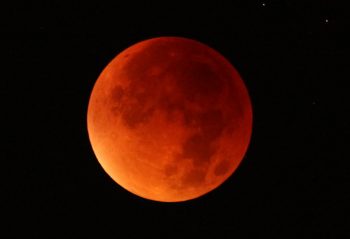
2015 Super Moon eclipse. Credit: ESA/CESAR
Normally we don’t observe during the Full Moon, because the complete side facing us is illuminated and is too bright. In principle it would be possible to search for impact flashes during the eclipse, as the Moon is in the shadow of the Earth — statistically speaking we may see one impact during the eclipse!
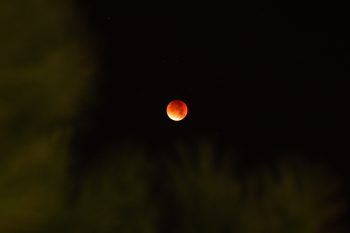
2015 Super Moon eclipse. Credit: ESA/CESAR
As for special results — some people measure the redness or darkness of the eclipse to deduce something about Earth’s atmosphere. The reason why the eclipsed Moon is red is because while in principle it is in the shadow of the Earth, the red sunlight still manages to pass through Earth’s atmosphere and is indirectly scattered onto the Moon. So, by looking at the intensity of the red Moon we could deduce something about our atmosphere. But as for our work on lunar flashes, eclipses don’t really give new science results — but are something beautiful to enjoy.
The Moon is as old as the Earth, at about 4.5 billion years of age. For as long as there have been creatures on Earth able to observe it, the Moon has been there to be seen.

The dimpled Moon. Credit: ESA/Silicon Worlds/Daniele Gasparri

Detlef during a Desert RATS ‘spacewalk’, 2011. Credit: ESA/W. Carey
In 450 BC the ancient Greek philosopher Anaxagoras realised that the Moon does not shine with its own light, instead bathing in the reflected glory of the radiant Sun. As early as 150 BC, the Greek philosopher ‘Seleucus of Seleucia’ considered the Moon to be the cause of tides on Earth.Today, we have landed on the Moon, leaving footprints, a feather from the famous “hammer-feather drop” experiment, even a cast golden olive branch lies amongst the countless other worldly possessions still orbiting Earth. More importantly we even brought lunar samples back home to study and explore. So, what more is there to know?
For a thousand years people have described witnessing mysterious, fleeting phenomena across the face of the Moon, and once we had the tools to observe its surface, we saw evidence of a history of high-energy bombardment in the countless craters and shock waves that blanket it.
It was only in 1997 that the first systematic attempts were made to identify impact flashes, and today ESA is one of a few organisations continuing to study these ‘transient lunar phenomena’.
We spoke to Detlef Koschny, ESA planetary scientist and co-manager of the near-Earth object section of ESA’s Space Situational Awareness programme, who is currently studying these impacts, finding out about the bits of space that keep smashing into our Moon…
Q: First of all, what is a lunar ‘impact flash’, and why are you interested?

Two lunar flashes light up darkened Moon, 17 – 18 July, 2018. Credit: J. Madiedo / MIDAS
There are many small, but fascinating and ancient pieces of material travelling at high speed through space, and I am interested in the smallest of them. My main research interest is cosmic dust, meteors, fireballs, and other minor bodies in the Solar System — particularly asteroids!
When a small asteroid or meteoroid hits the Moon, part of the energy is converted to light — and this is what we see as an ‘impact flash‘.
Q: How are you involved in studying these fleeting flashes?

Rosetta’s view of the Moon, 2007. Credit: ESA
I am involved in two projects whose main focus is lunar micrometeoroid impacts. NEOLITA was launched by ESA at at the National Observatory of Athens in February, 2015. It aims to determine the distribution and frequency of small near-earth objects (NEOs) by monitoring lunar impact flashes, using the 1.2m Kryoneri telescope located in the Northern Peloponnese, in Greece.
Like all other impact flash monitoring programmes, NEOLITA only observes impact flashes only on the dark side of the Moon — note that the dark side is entirely different to the far side!
Unlike the ‘far side’ of the Moon which always faces away from Earth (and has a slightly different surface) the dark side refers to any part of the Moon that is not currently illuminated by the Sun, although — such as during a crescent Moon — it may still be facing Earth.
Then there is LUMIO — the Lunar Meteoroid Impact Observer. ESA set a challenge last year (2017) — “Imagine sending a spacecraft the size of an airline cabin bag to the Moon – what would you have it do?” and LUMIO was one of the two successful answers!

The largest lunar flash ever recorded, September 2013. Credit: J. Madiedo / MIDAS
The plan is that LUMIO would circle over the far side of the Moon to detect bright impact flashes during the lunar night, mapping meteoroid bombardments as they occur!
Q: How common are they, and what can they tell us?
NELIOTA sees one flash on average every 2-3 hours of continuous observation time, so from that we can calculate that there are really are several per day.
The light flash lets us estimate the size and velocity of the object that hit it, and from this we can better understand how many of these objects hit the Moon, and how often. This is of particular interest to future astronauts that spend any time on the Moon! But this information also helps us understand the general environment that Earth and the Moon find themselves in — with some scaling factors to account for the different gravity of the two bodies, we can use the lunar data as a proxy for impacts into Earth’s atmosphere.

Differences between the near and far sides of the Moon. Credit: ESA
Q: How do impacts on the Moon differ from those on Earth?
Earth’s atmosphere protects us from objects smaller than about 20 metres, so to get impact craters on our surface we need even bigger asteroids that can survive, intact, before they reach the ground. On the Moon everything reaches the ground, because it doesn’t have an atmosphere. This means that we get ‘hypervelocity’ impact craters even from very small objects that impact it.
Q. Why are impacts on the dark side of the Moon important to study? Are they any different?
Impacts are the same everywhere on the Moon, but it is much easier to see the flash of light they cause if they occur on the dark, rather than illuminated, side. This is for the same reason that we can only see faint stars only at night and not during day — the contrast is just not high enough.
Q: Will the July 2018 eclipse provide any useful insights into lunar impacts?

2015 Super Moon eclipse. Credit: ESA/CESAR
Normally we don’t observe during the Full Moon, because the complete side facing us is illuminated and is too bright. In principle it would be possible to search for impact flashes during the eclipse, as the Moon is in the shadow of the Earth — statistically speaking we may see one impact during the eclipse!

2015 Super Moon eclipse. Credit: ESA/CESAR
As for special results — some people measure the redness or darkness of the eclipse to deduce something about Earth’s atmosphere. The reason why the eclipsed Moon is red is because while in principle it is in the shadow of the Earth, the red sunlight still manages to pass through Earth’s atmosphere and is indirectly scattered onto the Moon. So, by looking at the intensity of the red Moon we could deduce something about our atmosphere. But as for our work on lunar flashes, eclipses don’t really give new science results — but are something beautiful to enjoy.
Since starting Skeptical Science in 2007, I've been researching how to counter misinformation. One answer is inoculation - you can neutralize misinformation by exposing people to a "weak form of misinformation" (e.g., explain the techniques used to mislead). But how do we put this into practice?
One of the most powerful ways to teach science and counter science denial is in the classroom through misconception-based learning. I've been lucky enough to collaborate with several organizations to provide educational resources using this approach. The Skeptical Science team worked with UQx to develop the online course Making Sense of Climate Science Denial.
Now I'm based in the U.S., I've been lucky enough to collaborate with the National Center for Science Education and the Alliance of Climate Educators to develop a set of lesson plans teaching key facts about climate change while addressing five of the most common climate myths. With Brad Hoge (Director of Teacher Support at NCSE) and teachers from around the country who field-tested the lessons, we'll be presenting a five-part webinar series on how to teach our five lessons.
Each webinar will focus on a single NGSS-aligned lesson plan. You can sign up for free to any or all five to get the full complement of lessons. All participants will receive a certificate that can be used for continuing education units. The webinars will be at 7:00-8:30 pm Eastern Time via Zoom.
Register at https://secure.everyaction.com/EuBowp9HYUmbzuBz8uGZdw2
In this lesson, students create their own scientific consensus on climate change through direct interpretation with climate data, as well as examining a popular climate myth.
Some of the most common climate skeptic arguments focus on climate models. In this lesson, students examine climate model data and learn how climate models are developed, as well as debunk common misconceptions about climate models and their capabilities.
"Climate has always changed. Why is today any different?" With Milankovitch cycles (what?!), ice cores and other paleoclimate data, students explore the logical fallacy behind this misconception.
Let's take a gamble... In this lesson, students delve into local impacts of climate change and try their hand at beating the odds to see how climate change really is loading the dice and increasing the odds of more extreme weather.
What do wedges have to do with solving climate change? Turns out, everything. Students play the "Wedges Game" to balance various greenhouse gas-reductions strategies to achieve net zero emissions. Students also explore local climate solutions that works in their community.
Since starting Skeptical Science in 2007, I've been researching how to counter misinformation. One answer is inoculation - you can neutralize misinformation by exposing people to a "weak form of misinformation" (e.g., explain the techniques used to mislead). But how do we put this into practice?
One of the most powerful ways to teach science and counter science denial is in the classroom through misconception-based learning. I've been lucky enough to collaborate with several organizations to provide educational resources using this approach. The Skeptical Science team worked with UQx to develop the online course Making Sense of Climate Science Denial.
Now I'm based in the U.S., I've been lucky enough to collaborate with the National Center for Science Education and the Alliance of Climate Educators to develop a set of lesson plans teaching key facts about climate change while addressing five of the most common climate myths. With Brad Hoge (Director of Teacher Support at NCSE) and teachers from around the country who field-tested the lessons, we'll be presenting a five-part webinar series on how to teach our five lessons.
Each webinar will focus on a single NGSS-aligned lesson plan. You can sign up for free to any or all five to get the full complement of lessons. All participants will receive a certificate that can be used for continuing education units. The webinars will be at 7:00-8:30 pm Eastern Time via Zoom.
Register at https://secure.everyaction.com/EuBowp9HYUmbzuBz8uGZdw2
In this lesson, students create their own scientific consensus on climate change through direct interpretation with climate data, as well as examining a popular climate myth.
Some of the most common climate skeptic arguments focus on climate models. In this lesson, students examine climate model data and learn how climate models are developed, as well as debunk common misconceptions about climate models and their capabilities.
"Climate has always changed. Why is today any different?" With Milankovitch cycles (what?!), ice cores and other paleoclimate data, students explore the logical fallacy behind this misconception.
Let's take a gamble... In this lesson, students delve into local impacts of climate change and try their hand at beating the odds to see how climate change really is loading the dice and increasing the odds of more extreme weather.
What do wedges have to do with solving climate change? Turns out, everything. Students play the "Wedges Game" to balance various greenhouse gas-reductions strategies to achieve net zero emissions. Students also explore local climate solutions that works in their community.

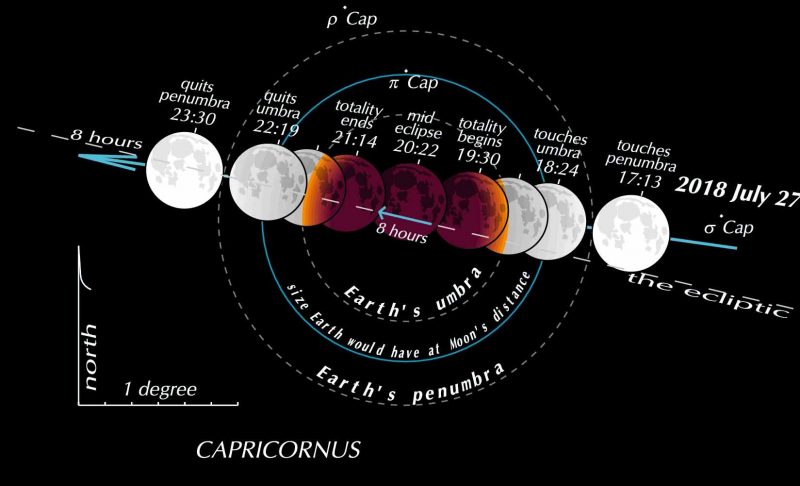
View larger. | Here is the view from Earth to the moon as it goes through our shadow on July 27, 2018. Chart via Guy Ottewell.
Originally published at Guy Ottewell’s blog and re-printed here with permission.
Read Part 1 of this article – on Mars’ 2018 opposition – here
Looking for links to online eclipse viewing? Click here
By the morning of July 27, 2018 – as registered on clocks in the Americas – Earth will have passed between the sun and Mars, and the Mars opposition will have passed. Near-perihelic oppositions like this one are the best in that the planet is nearer to us, so appears larger and brighter. Mars will be negligibly nearer a few days after opposition, and farther north from September onward. It will remain bright in our sky for at least another month, and into Northern autumn. But the main reason you might want to turn your telescope its way is: the moon.
As Mars came to opposition, the moon was marching toward it, so the sky has been flooded with moonglare. That continues until, around 10 hours after the opposition moment, the sky begins to darken as the moon encounters Earth’s shadow.
The moon is, at this month’s full time, only just short of reaching its descending node across the ecliptic. That is why it goes almost through the center of the shadow, and this will be a long total eclipse.
The umbra is the core shadow. No sunlight reaches it directly, but varying amounts can be refracted into it by Earth’s atmosphere. This is why it can appear brownish or even reddish, in patterns that vary at every eclipse. It is why the media have taken to calling a totally eclipsed moon a Blood Moon.
Read more: July 27 eclipse is this century’s longest eclipse
The image at top shows our view of the moon from Earth. And here is the moon’s view of Earth passing between it and the sun. This shows the hemisphere of Earth from which the moon is visible.

View larger. | These locations on Earth will view the July 27, 2018 eclipse. Chart via Guy Ottewell.
And here’s a timetable of what happens. (UT is Universal Time, CDT is North American Central Daylight Saving Time, BST is British Summer Time.)
– 17:13 UT (13:13 EDT, 18:13 BST): Beginning of penumbral eclipse: Earth’s pale outer shadow touches the moon, which is rising for Turkey, Egypt, Congo, is in the sky east of there, setting for Kamchatka and the southern Pacific.
– 18:24 UT (14:24 EDT, 19:24 BST): Beginning of partial eclipse: Earth’s dense inner shadow (the umbra) touches the moon, which is rising for eastern Europe, southern Italy, Libya, Nigeria; in the sky for much of Africa and Asia and all Australasia; setting for Hokkaido and the southern Pacific.
– 19:30 UT (15:30 EDT, 20:30 BST): Total eclipse begins: the moon is inside the umbra. It is rising for southern Scandinavia, Germany, mid France, mid Spain, Morocco, the southern Atlantic; up in the sky east of there; setting for Japan, Micronesia, New Zealand.
– 20:22 UT (16:22 EDT, 21:22 BST): Middle of the eclipse. The moon is in the sky for the hemisphere centered east of Madagascar.
– 21:14 UT (17:14 EDT, 22:14 BST): End of total eclipse: the advancing edge of the moon begins to leave the dark shadow. It is rising for the east coast of South America and for the Atlantic off Scotland, thus is low in the southeast for all of Britain and almost all of Scandinavia; is higher for the rest of Europe, all of Africa, half of Asia, is setting for eastern China, the Philippines, central Australia.
– 22:19 UT (18:19 EDT, 21:19 BST): End of partial eclipse: the last dark spot of Earth’s umbra quits the rear edge of the moon, which is rising for a bit of Iceland and for Venezuela, Bolivia, Chile; in the sky for Europe, Africa, Asia as far as where it is setting for western China, Borneo, western Australia. The inner part of the penumbra is faintly gray, the outer part indiscernible, so this is the practical end of the eclipse.
23:30 UT (19:30 EDT, 22:30 BST): End of eclipse: Earth’s outer shadow quits the moon, which is rising for Iceland, Newfoundland, Haiti, Colombia, Ecuador; in the sky for Europe, Africa, Asia as far as where it is setting for Bengal, a bit of Sumatra, the ocean off Australia.
In southern Britain, the moon rises about 19:40 UT, which is 20:40 BST. So the total eclipse has just begun.
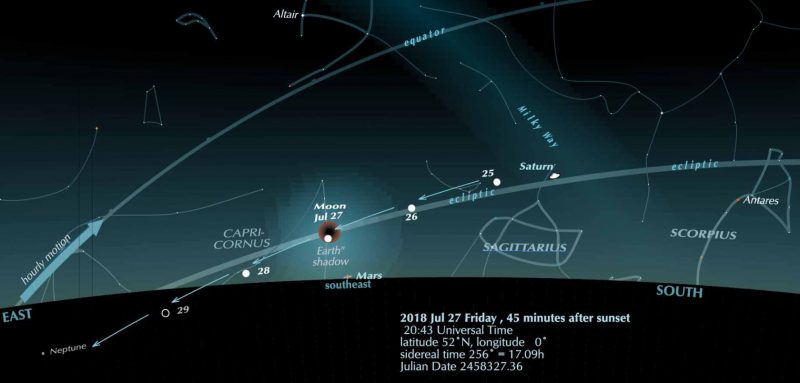
View larger. | Don’t forget! The totally eclipsed moon will be near Mars, now just one day from its 2018 opposition. Chart via Guy Ottewell.
Bottom line: July 27, 2018, total eclipse of the moon by Guy Ottewell. Looking for more? Try this article by Bruce McClure on the July 27 eclipse, which is this century’s longest lunar eclipse.


View larger. | Here is the view from Earth to the moon as it goes through our shadow on July 27, 2018. Chart via Guy Ottewell.
Originally published at Guy Ottewell’s blog and re-printed here with permission.
Read Part 1 of this article – on Mars’ 2018 opposition – here
Looking for links to online eclipse viewing? Click here
By the morning of July 27, 2018 – as registered on clocks in the Americas – Earth will have passed between the sun and Mars, and the Mars opposition will have passed. Near-perihelic oppositions like this one are the best in that the planet is nearer to us, so appears larger and brighter. Mars will be negligibly nearer a few days after opposition, and farther north from September onward. It will remain bright in our sky for at least another month, and into Northern autumn. But the main reason you might want to turn your telescope its way is: the moon.
As Mars came to opposition, the moon was marching toward it, so the sky has been flooded with moonglare. That continues until, around 10 hours after the opposition moment, the sky begins to darken as the moon encounters Earth’s shadow.
The moon is, at this month’s full time, only just short of reaching its descending node across the ecliptic. That is why it goes almost through the center of the shadow, and this will be a long total eclipse.
The umbra is the core shadow. No sunlight reaches it directly, but varying amounts can be refracted into it by Earth’s atmosphere. This is why it can appear brownish or even reddish, in patterns that vary at every eclipse. It is why the media have taken to calling a totally eclipsed moon a Blood Moon.
Read more: July 27 eclipse is this century’s longest eclipse
The image at top shows our view of the moon from Earth. And here is the moon’s view of Earth passing between it and the sun. This shows the hemisphere of Earth from which the moon is visible.

View larger. | These locations on Earth will view the July 27, 2018 eclipse. Chart via Guy Ottewell.
And here’s a timetable of what happens. (UT is Universal Time, CDT is North American Central Daylight Saving Time, BST is British Summer Time.)
– 17:13 UT (13:13 EDT, 18:13 BST): Beginning of penumbral eclipse: Earth’s pale outer shadow touches the moon, which is rising for Turkey, Egypt, Congo, is in the sky east of there, setting for Kamchatka and the southern Pacific.
– 18:24 UT (14:24 EDT, 19:24 BST): Beginning of partial eclipse: Earth’s dense inner shadow (the umbra) touches the moon, which is rising for eastern Europe, southern Italy, Libya, Nigeria; in the sky for much of Africa and Asia and all Australasia; setting for Hokkaido and the southern Pacific.
– 19:30 UT (15:30 EDT, 20:30 BST): Total eclipse begins: the moon is inside the umbra. It is rising for southern Scandinavia, Germany, mid France, mid Spain, Morocco, the southern Atlantic; up in the sky east of there; setting for Japan, Micronesia, New Zealand.
– 20:22 UT (16:22 EDT, 21:22 BST): Middle of the eclipse. The moon is in the sky for the hemisphere centered east of Madagascar.
– 21:14 UT (17:14 EDT, 22:14 BST): End of total eclipse: the advancing edge of the moon begins to leave the dark shadow. It is rising for the east coast of South America and for the Atlantic off Scotland, thus is low in the southeast for all of Britain and almost all of Scandinavia; is higher for the rest of Europe, all of Africa, half of Asia, is setting for eastern China, the Philippines, central Australia.
– 22:19 UT (18:19 EDT, 21:19 BST): End of partial eclipse: the last dark spot of Earth’s umbra quits the rear edge of the moon, which is rising for a bit of Iceland and for Venezuela, Bolivia, Chile; in the sky for Europe, Africa, Asia as far as where it is setting for western China, Borneo, western Australia. The inner part of the penumbra is faintly gray, the outer part indiscernible, so this is the practical end of the eclipse.
23:30 UT (19:30 EDT, 22:30 BST): End of eclipse: Earth’s outer shadow quits the moon, which is rising for Iceland, Newfoundland, Haiti, Colombia, Ecuador; in the sky for Europe, Africa, Asia as far as where it is setting for Bengal, a bit of Sumatra, the ocean off Australia.
In southern Britain, the moon rises about 19:40 UT, which is 20:40 BST. So the total eclipse has just begun.

View larger. | Don’t forget! The totally eclipsed moon will be near Mars, now just one day from its 2018 opposition. Chart via Guy Ottewell.
Bottom line: July 27, 2018, total eclipse of the moon by Guy Ottewell. Looking for more? Try this article by Bruce McClure on the July 27 eclipse, which is this century’s longest lunar eclipse.

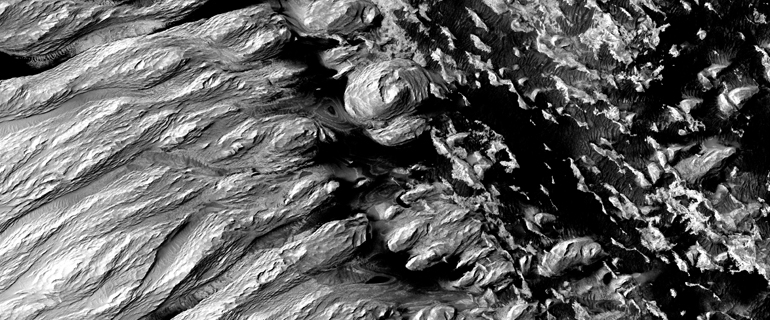
A portion of the Medusae Fossae Formation on Mars showing the effect of billions of years of erosion. The image comes from a camera onboard the Mars Reconnaissance Orbiter. Image via NASA/JPL/U. Arizona.
Mars is currently experiencing a planet-wide dust storm. Seasonal dust storms happen every Martian year, but global dust storms like the current one happen about every 10 or so years.
Like in the movie The Martian, where a dust storm strands an astronaut played by actor Matt Damon, the current dust storm on Mars is causing severe problems for real missions – for example, the Opportunity rover, which has had to suspend science operations. The fine, powdery stuff can get into expensive instruments and obscure solar panels needed to power equipment.
So where does all this dust come from? A new study says that the dust that coats much of the Martian surface originates largely from a single thousand-kilometer-long geological formation near the planet’s equator. The study, published July 20, 2018 in the peer-reviewed journal Nature Communications found a chemical match between dust in the Martian atmosphere and the surface feature, called the Medusae Fossae Formation.
Side-by-side movies shows how dust has enveloped the red planet, courtesy of the Mars Color Imager (MARCI) camera onboard NASA’s Mars Reconnaissance Orbiter (MRO). The view from May shows Valles Marineris chasms (left), Meridiani center, an autumn dust storm in Acidalia (top) and the early spring south polar cap (bottom). The view from July shows the same regions, but most of the surface was obscured by the planet-encircling dust cloud and haze.
Study co-author Kevin Lewis is an assistant professor of Earth and planetary science at the Johns Hopkins University. Lewis said in a statement:
Mars wouldn’t be nearly this dusty if it wasn’t for this one enormous deposit that is gradually eroding over time and polluting the planet, essentially.
The team studied data captured by the Mars Odyssey spacecraft, which has orbited the planet since 2001. They also looked at the Mars dust’s chemical composition. Landers and rovers far apart on the planet have all reported surprisingly similar data about the dust. Ojha said:
Dust everywhere on the planet is enriched in sulfur and chlorine and it has this very distinct sulfur-to-chlorine ratio.
The researchers were able to pinpoint the Medusae Fossae Formation region as having an abundance of sulfur and chlorine, as well as a match to the ratio of sulfur to chlorine in Mars dust.
Here on Earth, dust is separated from soft rock formations by forces of nature including wind, water, glaciers, volcanoes and meteor impacts. But on Mars, for more than 4 billion years, say the researchers, those forces have made only small contribution to the planet’s global dust reservoir. Study lead author Lujendra Ojha said:
How does Mars make so much dust, because none of these processes are active on Mars?
Earlier findings suggest that the Medusae Fossae Formation had a volcanic origin. Once the size of half continental United States, the wind has eroded it, leaving behind an area that’s now more like about 20 percent. Yet it is the largest known volcanic deposit in our solar system.
By calculating how much of the Medusae Fossae Formation has been lost over the past 3 billion years, the scientists could approximate the current quantity of dust on Mars, enough to form a 7 to 40 foot (2 to 12 meter) thick global layer.
Bottom line: A new study says that the dust that coats much of the surface of Mars originates largely from a single 1,000-kilometer-long (600-mile-long) geological formation near the planet’s equator called the Medusae Fossae Formation.
Read more from Johns Hopkins University


A portion of the Medusae Fossae Formation on Mars showing the effect of billions of years of erosion. The image comes from a camera onboard the Mars Reconnaissance Orbiter. Image via NASA/JPL/U. Arizona.
Mars is currently experiencing a planet-wide dust storm. Seasonal dust storms happen every Martian year, but global dust storms like the current one happen about every 10 or so years.
Like in the movie The Martian, where a dust storm strands an astronaut played by actor Matt Damon, the current dust storm on Mars is causing severe problems for real missions – for example, the Opportunity rover, which has had to suspend science operations. The fine, powdery stuff can get into expensive instruments and obscure solar panels needed to power equipment.
So where does all this dust come from? A new study says that the dust that coats much of the Martian surface originates largely from a single thousand-kilometer-long geological formation near the planet’s equator. The study, published July 20, 2018 in the peer-reviewed journal Nature Communications found a chemical match between dust in the Martian atmosphere and the surface feature, called the Medusae Fossae Formation.
Side-by-side movies shows how dust has enveloped the red planet, courtesy of the Mars Color Imager (MARCI) camera onboard NASA’s Mars Reconnaissance Orbiter (MRO). The view from May shows Valles Marineris chasms (left), Meridiani center, an autumn dust storm in Acidalia (top) and the early spring south polar cap (bottom). The view from July shows the same regions, but most of the surface was obscured by the planet-encircling dust cloud and haze.
Study co-author Kevin Lewis is an assistant professor of Earth and planetary science at the Johns Hopkins University. Lewis said in a statement:
Mars wouldn’t be nearly this dusty if it wasn’t for this one enormous deposit that is gradually eroding over time and polluting the planet, essentially.
The team studied data captured by the Mars Odyssey spacecraft, which has orbited the planet since 2001. They also looked at the Mars dust’s chemical composition. Landers and rovers far apart on the planet have all reported surprisingly similar data about the dust. Ojha said:
Dust everywhere on the planet is enriched in sulfur and chlorine and it has this very distinct sulfur-to-chlorine ratio.
The researchers were able to pinpoint the Medusae Fossae Formation region as having an abundance of sulfur and chlorine, as well as a match to the ratio of sulfur to chlorine in Mars dust.
Here on Earth, dust is separated from soft rock formations by forces of nature including wind, water, glaciers, volcanoes and meteor impacts. But on Mars, for more than 4 billion years, say the researchers, those forces have made only small contribution to the planet’s global dust reservoir. Study lead author Lujendra Ojha said:
How does Mars make so much dust, because none of these processes are active on Mars?
Earlier findings suggest that the Medusae Fossae Formation had a volcanic origin. Once the size of half continental United States, the wind has eroded it, leaving behind an area that’s now more like about 20 percent. Yet it is the largest known volcanic deposit in our solar system.
By calculating how much of the Medusae Fossae Formation has been lost over the past 3 billion years, the scientists could approximate the current quantity of dust on Mars, enough to form a 7 to 40 foot (2 to 12 meter) thick global layer.
Bottom line: A new study says that the dust that coats much of the surface of Mars originates largely from a single 1,000-kilometer-long (600-mile-long) geological formation near the planet’s equator called the Medusae Fossae Formation.
Read more from Johns Hopkins University

The full moon on the night of July 27-28, 2018, presents the longest total lunar eclipse of the 21st century (2001 to 2100). The total phase of the eclipse – called the totality – spans 1 hour 42 minutes and 57 seconds. That’s in contrast to the shortest total lunar eclipse of this century, which occurred on April 4, 2015 and lasted 4 minutes and 48 seconds. And it’s in contrast to 2018’s other total lunar eclipse – on January 31, 2018 – whose totality lasted 1 hour and 16 minutes.
A partial eclipse precedes and follows the total phase of the eclipse, each time lasting 1 hour and 6 minutes. So, from start to finish – on July 27-28, 2018 – the moon spends nearly 4 hours (3 hours and 55 minutes) crossing the Earth’s dark umbral shadow. Wow! That’s a long eclipse.
Adding to the excitement on eclipse night … this eclipse will happen on the same night that Earth is passing between the sun and Mars, placing Mars at opposition in our sky. In one of the sky’s wonderful coincidences, the Mars opposition happens on July 27, too. It’s not just any Mars opposition, but the best Mars opposition since 2003. Mars is very bright and red throughout July and August, 2018. But eclipse night will be a very special night. On July 27, the sun, Earth and moon are aligned – placing the moon opposite the sun in our sky – producing an eclipse as Earth’s shadow falls on the moon’s face. On the same night, the sun, Earth and Mars are also aligned, bringing Mars also opposite the sun in our sky, just like the full moon. That’s fun to think about, but there’s more for those who plan to observe the eclipse.
Picture it, if you will. During the long total phase of the July 27, 2018, lunar eclipse – the totality – the moon will turn red from sunlight filtering through Earth’s atmosphere onto the moon’s surface. And Mars will be near the moon, exceptionally bright – brighter than since 2003 – and red in color also.
Red moon, red Mars … does it get any better? Expect some great photos!
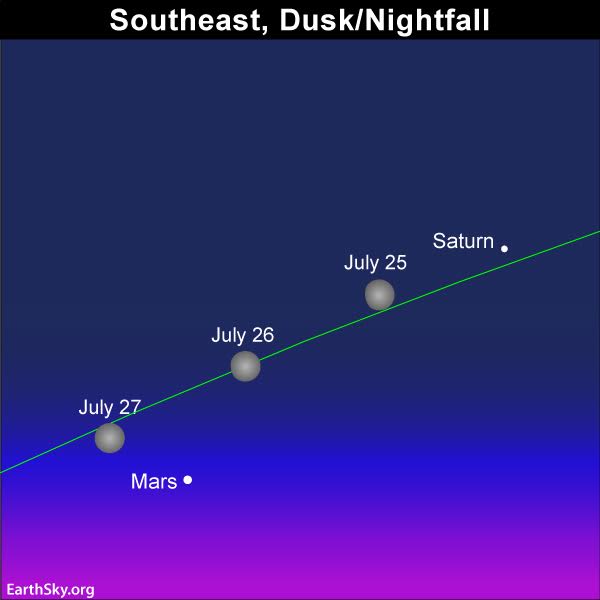
The eclipsed moon on July 27 will be close to the planet Mars, which – in July and August 2018 – is at the peak of its very special brightness as seen from Earth. Read more.
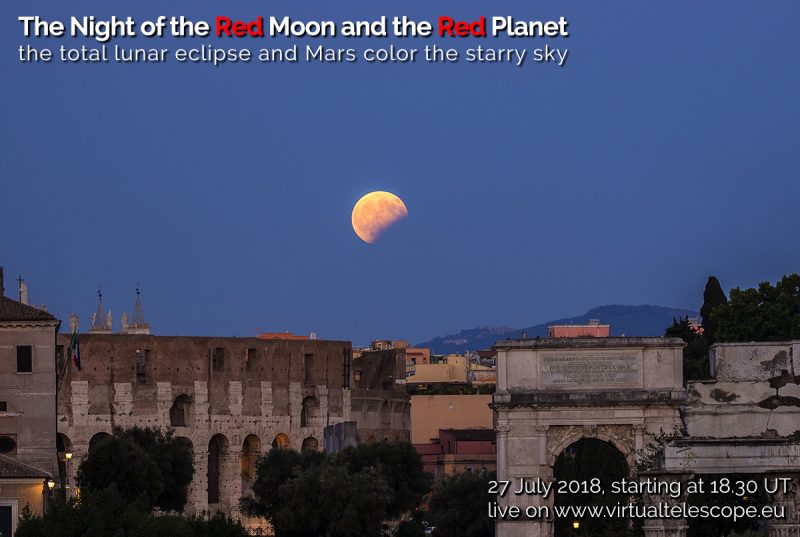
Clouded out on eclipse night, or on the wrong side of Earth? Never fear. The Virtual Telescope Project in Rome is offering a free live viewing. Click here for details. It starts at 18:30 UTC on July 27. That’s 2:30 p.m. EDT on July 27; translate UTC to your time.

Here’s another option for following the eclipse, live, free, online. This one offers a commentary in Spanish. The live broadcast of sky-live.tv starts at 18:20 UTC. It will cover both the partial and total eclipse with a commented-cam (in Spanish) and a sky-cam (only music), both located in Namibia (Africa). Click here for information.
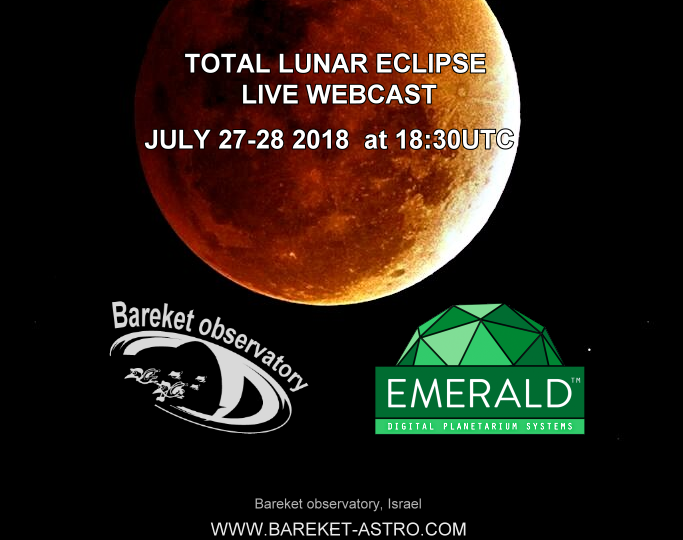
Free live lunar eclipse webcast from Bareket Observatory in Israel. Friday, July 27, 2018. This special webcast will start at 18:30 UTC and last about 5 hours. For more information, visit Bareket’s live page.
Now for the bad news for us in North America. This lunar eclipse is primarily visible from the world’s Eastern Hemisphere (Europe, Africa, Asia, Australia and New Zealand). South America, at least in part, can watch the final stages of the eclipse just after sunset July 27, whereas New Zealand will catch the beginning stages of the eclipse before sunrise July 28. North America, most of the Arctic and much of the Pacific Ocean will miss out entirely, as shown on the worldwide map below.
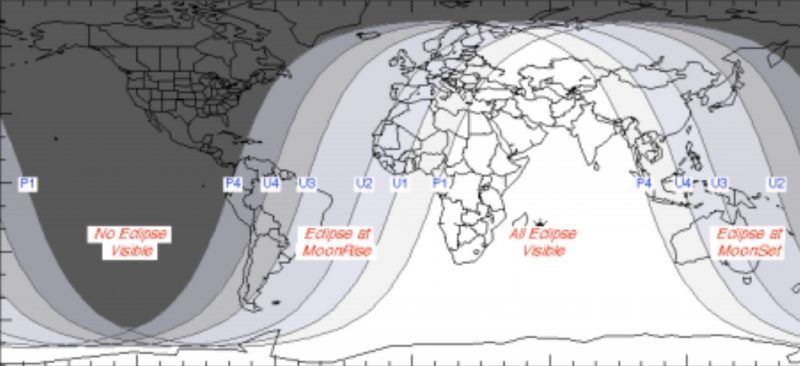
Worldwide map of the July 27, 2018, total lunar eclipse, via Fred Espenak’s EclipseWise.
The greatest eclipse (20:22 UTC) takes place at or around midnight for Madagascar and the Middle East. Europe and Africa view the greatest eclipse during the evening hours (sometime between sunset and midnight on July 27), whereas most of Asia, Indonesia and Australia view the greatest eclipse in the morning (sometime between midnight and sunrise on July 28).
We give you the eclipse times in Universal Time (UTC) below. You must convert these eclipse times from Universal Time into your local time. Here’s how. If it’s easier for you, the local times of the eclipse are available at TimeandDate.com (remember to put your place or country in the search box).
July 27, 2018
Partial eclipse begins: 18:24 (6:24 p.m.) UTC
Total eclipse begins: 19:30 (7:30 p.m.) UTC
Greatest eclipse: 20:22 (8:22 p.m.) UTC
Total eclipse ends: 21:13 (9:13 p.m.) UTC
Partial eclipse ends: 22:19 (10:19 p.m.) UTC

The moon crosses the Earth’s shadow from west to east, entering the dark umbra (inner shadow) at 18:24 UTC and leaving it at 22:19 UTC. The penumbra (outer shadow) is so faint that you may not notice any darkening of the moon while it’s in the penumbra.
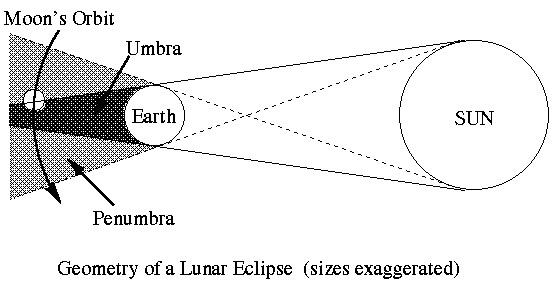
Earth’s shadow has two parts: a dark inner umbra and lighter surrounding penumbra. When Earth’s penumbral shadow falls on the moon, it creates a very subtle eclipse – a shading on the moon’s surface. When the darker umbral shadow falls on the moon, it appears as if a “bite” has been taken from the moon’s face. Illustration via astro.washington.edu.
What causes a long-lasting total lunar eclipse?
For an especially long-lasting total lunar eclipse of 1 hour and 43 minutes to occur, the moon has to pass through the central part of the Earth’s shadow. The previous total lunar eclipse on January 31, 2018, didn’t last as long (1 hour and 16 minutes) because the moon passed to the south of the shadow’s center; and the next total lunar eclipse on January 21, 2019, won’t be as long either (1 hour and 2 minutes) because it’ll pass to the north of the shadow’s center.
In 2018, the July full moon and July lunar apogee – the moon’s most distant point from Earth in its monthly orbit – both fall on the same date: July 27, 2018. Therefore, the July 2018 full moon showcases the most distant and smallest full moon of the year. Sometimes called an apogean full moon (or micro-moon or mini-moon), this smaller and slower-moving full moon takes more time to cross the Earth’s shadow than does a full moon that’s closer to Earth and moving faster in orbit. That’s why a full moon at or near lunar apogee adds to the duration of a total lunar eclipse.
The longest possible total lunar eclipse is 1 hour and 47 minutes. In fact, the longest total eclipse of the 20th century (1901 to 2000) occurred on July 16, 2000, with a duration of 1 hour and 46.4 minutes. That’s because, at greatest eclipse, the center of the lunar disk aligned almost perfectly with the center of the Earth’s shadow.
It’s no coincidence, by the way, that the extra-long total lunar eclipses of July 16, 2000, and July 27, 2018, belong to the same Saros series and are separated by one Saros period (18.031 years).
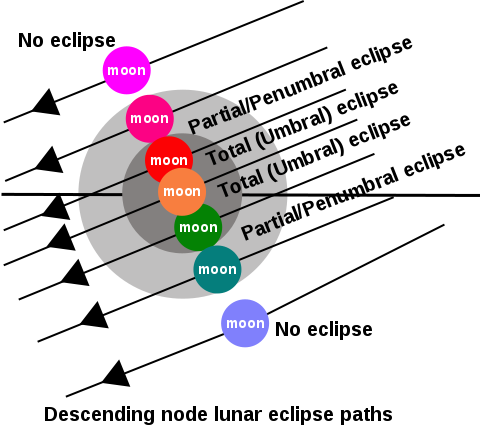
The moon crosses the ecliptic (Earth’s orbital plane) from north to south. This descending node Saros series starts when the moon first clips the southernmost part (bottom) of Earth’s shadow and then migrates northward (upward) with each succeeding Saros period of 18.031 years. Midway through the Saros series, the full moon passes through the center of Earth’s shadow for a maximally long total lunar eclipse. Saros Series 129, of which the total lunar eclipse on July 27, 2018, is a part, lasts for a total of 1,262 years. Image via Matthew Zimmerman.
On July 27, 2018, the center of the lunar disk will swing a tiny bit north of the shadow’s center, so this total lunar eclipse with a duration of 1 hour and 43 minutes will be a few minutes shy of the maximum duration possible (1 hour and 47 minutes). Even so, this July 2018 total lunar eclipse counts as a whopper, giving us the longest total lunar eclipse of the 21st century.
The longest total lunar eclipses of the 20th and 21st centuries both take place in July, which is of consequence. That’s because yearly, in early July, the Earth swings out to aphelion – its farthest point from the sun for the year.
At aphelion, the Earth’s dark umbral shadow reaches its maximum length (and width) for the year. All else being equal (moon’s distance and centrality of eclipse), the greater width of the Earth’s umbra in July means a longer total lunar eclipse. Therefore, long-lasting total lunar eclipses tend to take place in a Northern Hemisphere summer (or Southern Hemisphere winter) because the umbra is wider at this time of year.
The full moon will plunge deeply into the Earth’s shadow on the night of July 27-28, 2018. Depending on atmospheric conditions, this could be an especially dark total eclipse, though you won’t know for sure unless you look!
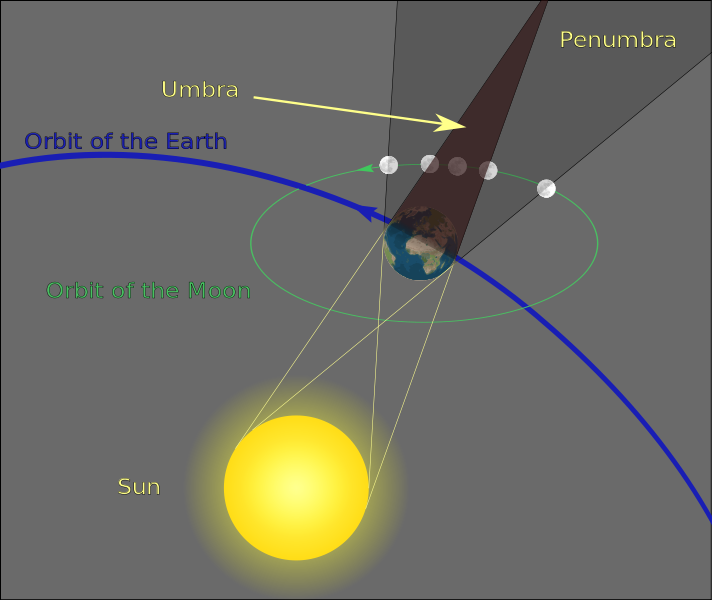
During a total lunar eclipse, the moon always passes through Earth’s very light penumbral shadow before and after its journey through the dark umbra.
Bottom line: July 27, 2018, brings the longest total eclipse of the moon of the 21st century. It happens when the most distant and smallest full moon of the year passes through the center of the Earth’s shadow, which is at its widest in July. And it happens on a night when the moon is near Mars, which also comes to opposition on July 27. What a night!

The full moon on the night of July 27-28, 2018, presents the longest total lunar eclipse of the 21st century (2001 to 2100). The total phase of the eclipse – called the totality – spans 1 hour 42 minutes and 57 seconds. That’s in contrast to the shortest total lunar eclipse of this century, which occurred on April 4, 2015 and lasted 4 minutes and 48 seconds. And it’s in contrast to 2018’s other total lunar eclipse – on January 31, 2018 – whose totality lasted 1 hour and 16 minutes.
A partial eclipse precedes and follows the total phase of the eclipse, each time lasting 1 hour and 6 minutes. So, from start to finish – on July 27-28, 2018 – the moon spends nearly 4 hours (3 hours and 55 minutes) crossing the Earth’s dark umbral shadow. Wow! That’s a long eclipse.
Adding to the excitement on eclipse night … this eclipse will happen on the same night that Earth is passing between the sun and Mars, placing Mars at opposition in our sky. In one of the sky’s wonderful coincidences, the Mars opposition happens on July 27, too. It’s not just any Mars opposition, but the best Mars opposition since 2003. Mars is very bright and red throughout July and August, 2018. But eclipse night will be a very special night. On July 27, the sun, Earth and moon are aligned – placing the moon opposite the sun in our sky – producing an eclipse as Earth’s shadow falls on the moon’s face. On the same night, the sun, Earth and Mars are also aligned, bringing Mars also opposite the sun in our sky, just like the full moon. That’s fun to think about, but there’s more for those who plan to observe the eclipse.
Picture it, if you will. During the long total phase of the July 27, 2018, lunar eclipse – the totality – the moon will turn red from sunlight filtering through Earth’s atmosphere onto the moon’s surface. And Mars will be near the moon, exceptionally bright – brighter than since 2003 – and red in color also.
Red moon, red Mars … does it get any better? Expect some great photos!

The eclipsed moon on July 27 will be close to the planet Mars, which – in July and August 2018 – is at the peak of its very special brightness as seen from Earth. Read more.

Clouded out on eclipse night, or on the wrong side of Earth? Never fear. The Virtual Telescope Project in Rome is offering a free live viewing. Click here for details. It starts at 18:30 UTC on July 27. That’s 2:30 p.m. EDT on July 27; translate UTC to your time.

Here’s another option for following the eclipse, live, free, online. This one offers a commentary in Spanish. The live broadcast of sky-live.tv starts at 18:20 UTC. It will cover both the partial and total eclipse with a commented-cam (in Spanish) and a sky-cam (only music), both located in Namibia (Africa). Click here for information.

Free live lunar eclipse webcast from Bareket Observatory in Israel. Friday, July 27, 2018. This special webcast will start at 18:30 UTC and last about 5 hours. For more information, visit Bareket’s live page.
Now for the bad news for us in North America. This lunar eclipse is primarily visible from the world’s Eastern Hemisphere (Europe, Africa, Asia, Australia and New Zealand). South America, at least in part, can watch the final stages of the eclipse just after sunset July 27, whereas New Zealand will catch the beginning stages of the eclipse before sunrise July 28. North America, most of the Arctic and much of the Pacific Ocean will miss out entirely, as shown on the worldwide map below.

Worldwide map of the July 27, 2018, total lunar eclipse, via Fred Espenak’s EclipseWise.
The greatest eclipse (20:22 UTC) takes place at or around midnight for Madagascar and the Middle East. Europe and Africa view the greatest eclipse during the evening hours (sometime between sunset and midnight on July 27), whereas most of Asia, Indonesia and Australia view the greatest eclipse in the morning (sometime between midnight and sunrise on July 28).
We give you the eclipse times in Universal Time (UTC) below. You must convert these eclipse times from Universal Time into your local time. Here’s how. If it’s easier for you, the local times of the eclipse are available at TimeandDate.com (remember to put your place or country in the search box).
July 27, 2018
Partial eclipse begins: 18:24 (6:24 p.m.) UTC
Total eclipse begins: 19:30 (7:30 p.m.) UTC
Greatest eclipse: 20:22 (8:22 p.m.) UTC
Total eclipse ends: 21:13 (9:13 p.m.) UTC
Partial eclipse ends: 22:19 (10:19 p.m.) UTC

The moon crosses the Earth’s shadow from west to east, entering the dark umbra (inner shadow) at 18:24 UTC and leaving it at 22:19 UTC. The penumbra (outer shadow) is so faint that you may not notice any darkening of the moon while it’s in the penumbra.

Earth’s shadow has two parts: a dark inner umbra and lighter surrounding penumbra. When Earth’s penumbral shadow falls on the moon, it creates a very subtle eclipse – a shading on the moon’s surface. When the darker umbral shadow falls on the moon, it appears as if a “bite” has been taken from the moon’s face. Illustration via astro.washington.edu.
What causes a long-lasting total lunar eclipse?
For an especially long-lasting total lunar eclipse of 1 hour and 43 minutes to occur, the moon has to pass through the central part of the Earth’s shadow. The previous total lunar eclipse on January 31, 2018, didn’t last as long (1 hour and 16 minutes) because the moon passed to the south of the shadow’s center; and the next total lunar eclipse on January 21, 2019, won’t be as long either (1 hour and 2 minutes) because it’ll pass to the north of the shadow’s center.
In 2018, the July full moon and July lunar apogee – the moon’s most distant point from Earth in its monthly orbit – both fall on the same date: July 27, 2018. Therefore, the July 2018 full moon showcases the most distant and smallest full moon of the year. Sometimes called an apogean full moon (or micro-moon or mini-moon), this smaller and slower-moving full moon takes more time to cross the Earth’s shadow than does a full moon that’s closer to Earth and moving faster in orbit. That’s why a full moon at or near lunar apogee adds to the duration of a total lunar eclipse.
The longest possible total lunar eclipse is 1 hour and 47 minutes. In fact, the longest total eclipse of the 20th century (1901 to 2000) occurred on July 16, 2000, with a duration of 1 hour and 46.4 minutes. That’s because, at greatest eclipse, the center of the lunar disk aligned almost perfectly with the center of the Earth’s shadow.
It’s no coincidence, by the way, that the extra-long total lunar eclipses of July 16, 2000, and July 27, 2018, belong to the same Saros series and are separated by one Saros period (18.031 years).

The moon crosses the ecliptic (Earth’s orbital plane) from north to south. This descending node Saros series starts when the moon first clips the southernmost part (bottom) of Earth’s shadow and then migrates northward (upward) with each succeeding Saros period of 18.031 years. Midway through the Saros series, the full moon passes through the center of Earth’s shadow for a maximally long total lunar eclipse. Saros Series 129, of which the total lunar eclipse on July 27, 2018, is a part, lasts for a total of 1,262 years. Image via Matthew Zimmerman.
On July 27, 2018, the center of the lunar disk will swing a tiny bit north of the shadow’s center, so this total lunar eclipse with a duration of 1 hour and 43 minutes will be a few minutes shy of the maximum duration possible (1 hour and 47 minutes). Even so, this July 2018 total lunar eclipse counts as a whopper, giving us the longest total lunar eclipse of the 21st century.
The longest total lunar eclipses of the 20th and 21st centuries both take place in July, which is of consequence. That’s because yearly, in early July, the Earth swings out to aphelion – its farthest point from the sun for the year.
At aphelion, the Earth’s dark umbral shadow reaches its maximum length (and width) for the year. All else being equal (moon’s distance and centrality of eclipse), the greater width of the Earth’s umbra in July means a longer total lunar eclipse. Therefore, long-lasting total lunar eclipses tend to take place in a Northern Hemisphere summer (or Southern Hemisphere winter) because the umbra is wider at this time of year.
The full moon will plunge deeply into the Earth’s shadow on the night of July 27-28, 2018. Depending on atmospheric conditions, this could be an especially dark total eclipse, though you won’t know for sure unless you look!

During a total lunar eclipse, the moon always passes through Earth’s very light penumbral shadow before and after its journey through the dark umbra.
Bottom line: July 27, 2018, brings the longest total eclipse of the moon of the 21st century. It happens when the most distant and smallest full moon of the year passes through the center of the Earth’s shadow, which is at its widest in July. And it happens on a night when the moon is near Mars, which also comes to opposition on July 27. What a night!